Related Research Articles

Pseudo-Dionysius the Areopagite was a Syrian Christian theologian and Neoplatonic philosopher of the late 5th to early 6th century, who wrote a set of works known as the Corpus Areopagiticum or Corpus Dionysiacum.
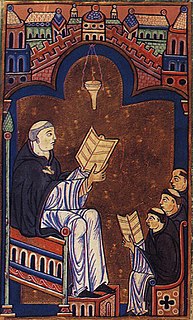
Richard of Saint Victor was a Medieval Scottish philosopher and theologian and one of the most influential religious thinkers of his time. A canon regular, he was a prominent mystical theologian, and was prior of the famous Augustinian Abbey of Saint Victor in Paris from 1162 until his death in 1173.
Adam Marsh was an English Franciscan, scholar and theologian. Marsh became, after Robert Grosseteste, "...the most eminent master of England."
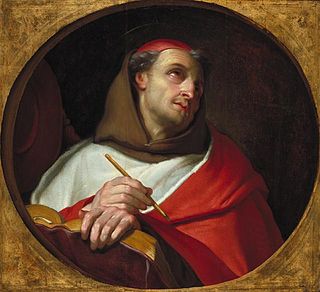
Bonaventure, born Giovanni di Fidanza, was an Italian medieval Franciscan, scholastic theologian and philosopher. The seventh Minister General of the Order of Friars Minor, he was also Cardinal Bishop of Albano. He was canonised on 14 April 1482 by Pope Sixtus IV and declared a Doctor of the Church in the year 1588 by Pope Sixtus V. He is known as the "Seraphic Doctor". His feast day is July 15. Many writings believed in the Middle Ages to be his are now collected under the name Pseudo-Bonaventure.
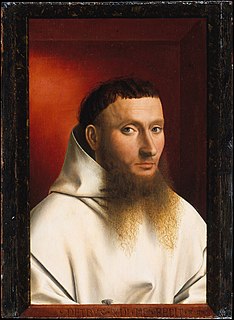
Denis the Carthusian (1402–1471), also known as Denys van Leeuwen, Denis Ryckel, Dionysius van Rijkel, was a Roman Catholic theologian and mystic.
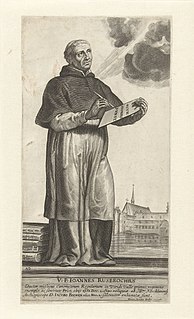
John van Ruysbroeck, original Flemish name Jan van Ruusbroec was an Augustinian canon and one of the most important of the Flemish mystics. Some of his main literary works include The Kingdom of the Divine Lovers, The Twelve Beguines, The Spiritual Espousals, A Mirror of Eternal Blessedness, The Little Book of Enlightenment, and The Sparkling Stone. Some of his letters also survive, as well as several short sayings. He wrote in the Dutch vernacular, the language of the common people of the Low Countries, rather than in Latin, the language of the Catholic Church liturgy and official texts, in order to reach a wider audience.

Richard Rolle was an English hermit, mystic, and religious writer. He is also known as Richard Rolle of Hampole or de Hampole, since at the end of his life he lived near a Cistercian nunnery in Hampole, now in South Yorkshire. In the words of Nicholas Watson, scholarly research has shown that "[d]uring the fifteenth century he was one of the most widely read of English writers, whose works survive in nearly four hundred English ... and at least seventy Continental manuscripts, almost all written between 1390 and 1500."

Hugh of Saint Victor, was a Saxon canon regular and a leading theologian and writer on mystical theology.
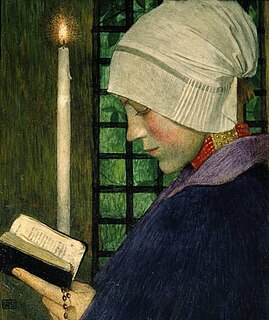
Christian meditation is a form of prayer in which a structured attempt is made to become aware of and reflect upon the revelations of God. The word meditation comes from the Latin word meditārī, which has a range of meanings including to reflect on, to study, and to practice. Christian meditation is the process of deliberately focusing on specific thoughts and reflecting on their meaning in the context of the love of God.
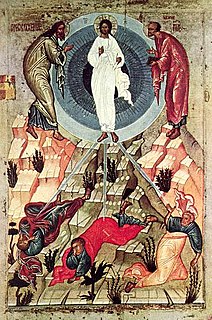
Walter Hilton Can.Reg. was an English Augustinian mystic. His works became influential in the 15th century in England and Wales. He has been canonized by the Church of England and by the Episcopal Church in the United States.
Henry de Beaume, O.F.M., , also known as Hugh Balme, was a Franciscan friar, priest and theologian. He became a supporter of the reform work of Colette of Corbie, among the Poor Clare nuns, which, in turn, led a reform movement of his own branch of the Franciscan Order. He is honored as a Blessed within the Order.
Theologia Germanica, also known as Theologia Deutsch or Teutsch, or as Der Franckforter, is a mystical treatise believed to have been written in the later 14th century by an anonymous author. According to the introduction of the Theologia the author was a priest and a member of the Teutonic Order living in Frankfurt, Germany.

Thomas Gallus of Vercelli, sometimes in early twentieth century texts called Thomas of St Victor, Thomas of Vercelli or Thomas Vercellensis, was a French theologian, a member of the School of St Victor. He is known for his commentaries on Pseudo-Dionysius and his ideas on affective theology. His elaborate mystical schemata influenced Bonaventure and The Cloud of Unknowing.
Hendrik Herp, known in Latin as Henricus Harphius, was a Dutch or Flemish Franciscan of the Strict Observance, and a writer on mysticism.
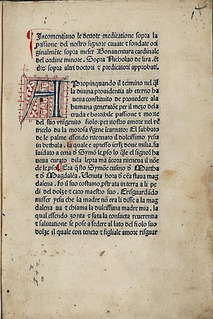
Pseudo-Bonaventure is the name given to the authors of a number of medieval devotional works which were believed at the time to be the work of Bonaventure: "It would almost seem as if 'Bonaventura' came to be regarded as a convenient label for a certain type of text, rather than an assertion of authorship". Since it is clear a number of actual authors are involved, the term "Pseudo-Bonaventuran" is often used. Many works now have other attributions of authorship which are generally accepted, but the most famous, the Meditations on the Life of Christ, remains usually described only as a work of Pseudo-Bonaventure.

Eckhart von Hochheim, commonly known as Meister Eckhart or Eckehart, was a German theologian, philosopher and mystic, born near Gotha in the Landgraviate of Thuringia in the Holy Roman Empire.

Guigo II, sometimes referred to as Guy, or by the moniker "the Angelic", was a Carthusian monk and the 9th prior of Grande Chartreuse monastery, from 1174-80.
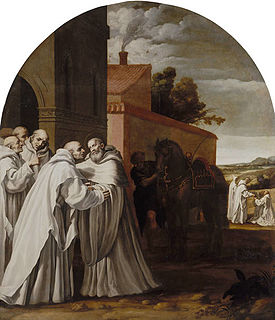
Guigo I also known as Guigues du Chastel, Guigo de Castro and Guigo of Saint-Romain, was a Carthusian monk and the 5th prior of Grande Chartreuse monastery in the 12th century. He was born in 1083 near the Chateau of Saint-Romain, and entered the Grande Chartreuse in 1106.
Guigo de Ponte, also known as Guigues du Pont, was a Carthusian monk of the Grande Chartreuse. Little is known about him, but he probably professed there in 1271, and died in 1297.
Classics of Western Spirituality [CWS] is an English-language book series published by Paulist Press between 1978 and the present, which offers an extensive library of historical texts on Christian spirituality as well as a representative selection of works on Jewish, Islamic, Sufi and Native American spirituality. Each volume is critically selected and translated by one or more internationally recognized scholars and spiritual leaders, with scholarly introductions and carefully selected bibliographies of both primary and secondary materials. The series contains multiple genres of spiritual writing, including poems, songs, essays, theological treatises, meditations, mystical biographies, and philosophical investigations, and features works by famous authors such as Augustine of Hippo and Martin Luther as well as lesser known authors such as Maximus the Confessor and Moses de León.
References
- ↑ The 1913 Catholic Encyclopedia states that Hugh of Balma was a Franciscan - but, as pointed out below, this is now acknowledged not to have been the case.
- ↑ The Cloud of Unknowing, ed James Walsh, (New York: Paulist Press, 1981), p.19.
- ↑ Some works give the dates as 1289-1304, for reasons unclear.
- ↑ Jasper Hopkins, Hugh of Balma on Mystical Theology: A Translation and an Overview of His De Theologia Mystica, (Minneapolis, MN: Banning, 2002), p. 2; Carthusian spirituality: the writings of Hugh of Balma and Guigo de Ponte trans by Dennis D. Martin, (New York: Paulist Press, 1996), p. 9.
- ↑ "Henry Balme (Or Balma; also called Hugh)". Catholic Encyclopedia, New Advent. Retrieved 2014-07-23.
- ↑ Carthusian spirituality: the writings of Hugh of Balma and Guigo de Ponte trans by Dennis D. Martin, (New York: Paulist Press, 1996), p. 18.
- ↑ Carthusian spirituality: the writings of Hugh of Balma and Guigo de Ponte trans by Dennis D. Martin, (New York: Paulist Press, 1996), p. 22.
- ↑ Jasper Hopkins, Hugh of Balma on Mystical Theology: A Translation and an Overview of His De Theologia Mystica, (Minneapolis, MN: Banning, 2002), p. 2.
- ↑ Carthusian spirituality: the writings of Hugh of Balma and Guigo de Ponte trans by Dennis D. Martin, (New York: Paulist Press, 1996), p. 12.
- ↑ Carthusian spirituality: the writings of Hugh of Balma and Guigo de Ponte trans by Dennis D. Martin, (New York: Paulist Press, 1996), pp13-4, 58.
- ↑ Carthusian spirituality: the writings of Hugh of Balma and Guigo de Ponte trans by Dennis D. Martin, (New York: Paulist Press, 1996), p. 56.